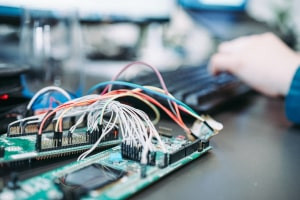An embedded system is a computer system containing the computer processor, memory, and input and output peripheral devices. In this course, you will be introduced to the development and design of embedded systems. You will examine the various applications and implementation of embedded systems as well as the contrasts between embedded computers and general-purpose computer systems. There are many ways of installing an embedded computer and one of the popular methods is using a microcontroller, which is a complete computer on a single chip. You will learn the classification of a microcontroller, how to choose the right device for your project, as well as its various features and functionalities. The ecosystem that a microcontroller requires and how to select a suitable embedded controller according to packaging will also be taught. Thereafter, you will study the properties, sources and classification of clock and reset subsystems. The program download capacity of the microcontroller ecosystem, the design of the power supply, and the required power supply for the microcontroller will be highlighted.
Next, you will be introduced to the features and working principles of the MSP430 microcontroller. The MSP430 is a mixed-signal entry-level microcontroller from Texas Instruments and is one of the oldest offerings as far as microcontrollers are concerned. The type of processer and series, as well as the important features and architecture of the MSP430G2x52, will also be examined. You will learn how to operate an MSP430 circuit with the help of a lemon battery, which is made out of lemons and two electrodes made out of copper and zinc. The MSP430 series memory architecture and map with a focus on the G2553 microcontroller will be highlighted. The 16 registers of the CPU of MSP430 with emphasis on four special purpose registers, namely program counter, stack pointer, status register and constant generator, will be analyzed. You will also consider the flash memory of the MSP430 microcontroller, the types, structure and the RAM. The various ways of programming the MSP430 and how to write programs and download them on the memory of the evaluation kit of the MSP430 LunchBox will be highlighted. The Code Composer Studio integrated development environment and the MSP430 download mechanisms will also be analyzed.
Finally, you will be taken through the input and output devices of the MSP430. You will study the various ways in which a user can interact or provide input to the microcontroller. The various input and output devices of the MSP430 microcontroller will be outlined. You will also consider the types of switches and how to connect a switch to a microcontroller. Then, you will be introduced to the methods of connecting LEDs to a microcontroller. The RGB LED and the 7-segment displays of the LED as well as how to increase the currents of the LED will be explained. Also, you will learn how to operate a transistor in a switch-mode and how to ensure that the LED current remains constant in a battery with voltages going down. Thereafter, you will be taught how to use a microcontroller to connect to a multiplex display (4-digit 7-segment display) using PNP transistors. The features of the IC ULN2803 transistor as well as the low and high side LED drivers will be highlighted. The methods of controlling a large amount of current through LEDs and controlling relays using low- and high-side switches will be discussed. At the end of this course, you can expect to be able to design simple embedded systems from scratch. This online course is unique and has a hands-on approach for learning to operate significant hardware components in an embedded system. So, why wait? Start this course today.
What You Will Learn In This Free Course
View All Learning Outcomes View Less All Alison courses are free to enrol, study, and complete. To successfully complete this Certificate course and become an Alison Graduate, you need to achieve 80% or higher in each course assessment.
Once you have completed this Certificate course, you have the option to acquire an official Certificate, which is a great way to share your achievement with the world.
Your Alison certificate is:
- Ideal for sharing with potential employers.
- Great for your CV, professional social media profiles, and job applications.
- An indication of your commitment to continuously learn, upskill, and achieve high results.
- An incentive for you to continue empowering yourself through lifelong learning.
Alison offers 2 types of Certificate for completed Certificate courses:
- Digital Certificate: a downloadable Certificate in PDF format immediately available to you when you complete your purchase.
- Physical Certificate: a physical version of your officially branded and security-marked Certificate
All Certificate are available to purchase through the Alison Shop. For more information on purchasing Alison Certificate, please visit our FAQs. If you decide not to purchase your Alison Certificate, you can still demonstrate your achievement by sharing your Learner Record or Learner Achievement Verification, both of which are accessible from your Account Settings.











 Avg. Hours
Avg. Hours  Contains Video
Contains Video  CPD Accredited
CPD Accredited 
 Total XP:
Total XP: 
 Knowledge & Skills You Will Learn
Knowledge & Skills You Will Learn 







